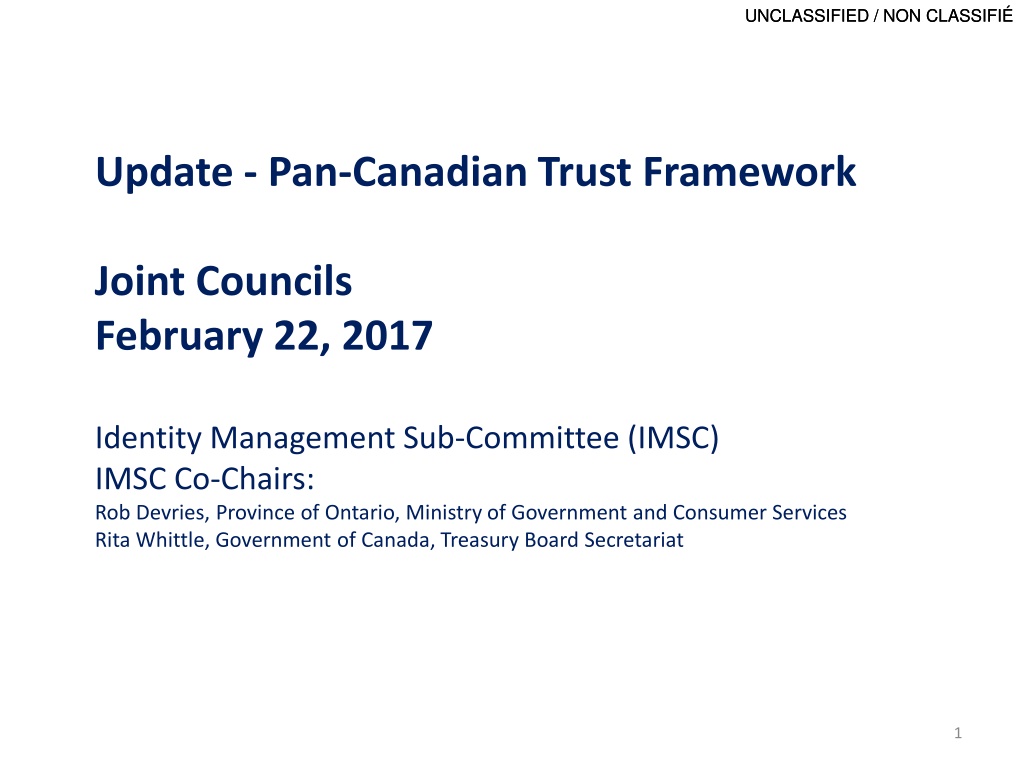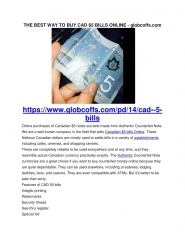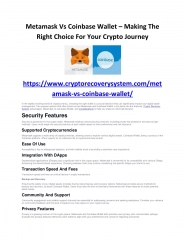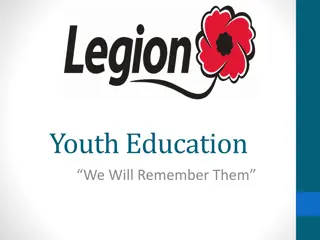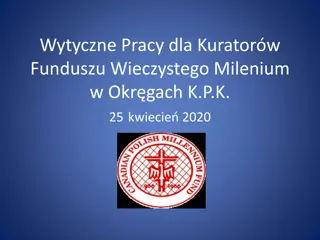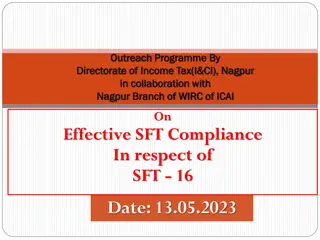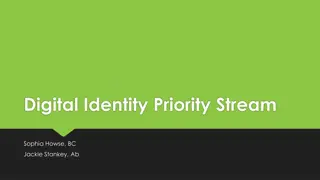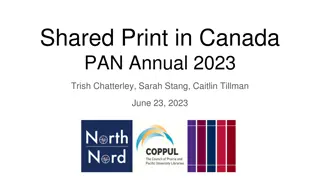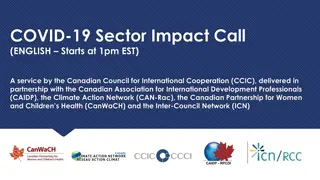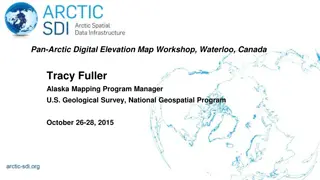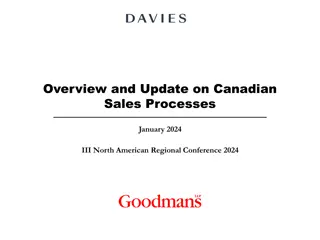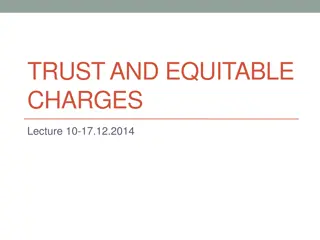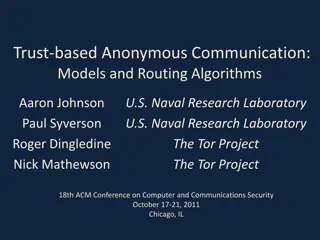Pan-Canadian Trust Framework Update
The update on the Pan-Canadian Trust Framework from February 22, 2017, provides insights into the Identity Management Sub-Committee's activities, objectives, history, and future steps. The framework aims to establish trusted digital identities ensuring secure interactions in the public and private sectors.
Download Presentation

Please find below an Image/Link to download the presentation.
The content on the website is provided AS IS for your information and personal use only. It may not be sold, licensed, or shared on other websites without obtaining consent from the author. Download presentation by click this link. If you encounter any issues during the download, it is possible that the publisher has removed the file from their server.
E N D
Presentation Transcript
UNCLASSIFIED / NON CLASSIFI UNCLASSIFIED / NON CLASSIFI Update - Pan-Canadian Trust Framework Joint Councils February 22, 2017 Identity Management Sub-Committee (IMSC) IMSC Co-Chairs: Rob Devries, Province of Ontario, Ministry of Government and Consumer Services Rita Whittle, Government of Canada, Treasury Board Secretariat 1
UNCLASSIFIED / NON CLASSIFI Objectives 1. Pan-Canadian Trust Framework A Brief History 2. Progress update on Pan-Canadian Trust Framework Activities and Deliverables 3. Risks and Mitigation Discussion 4. Proposed Next Steps 2
UNCLASSIFIED / NON CLASSIFI Pan-Canadian Trust Framework - A Brief History In January 2015, the Co-chairs of the F-P/T Deputy Ministers Table on Service Delivery Collaboration presented to the Clerks and Cabinet Secretaries Committee. Three priority areas were identified: Service to Business Identity Management Open Data Business Number (BN) Common Open Data licensing, principles and standards Pan-Canadian Identity Trust Framework Federal and F-P/T service bundling and other collaborative initiatives Federated dataset search Implementation of the Identity Validation Standard Stakeholder growth: data literacy, promotion, and outreach Expedited Business Start (EBS) Canada s Digital Interchange (CDI) DMs identified these enabling priorities to advance a digital-first, 24/7, and tell-us-once approach for Canadians. 3
UNCLASSIFIED / NON CLASSIFI PAN-CANADIAN TRUST FRAMEWORK What is the Pan-Canadian Trust Framework? Trusted Digital Identity A n e n a b l e r fo r d i g i t a l s e r v i c e Including Public Sector and Private Sector Considerations Has the user given consent ? Is it the same person? Is it a real existing person? Verified Person Component Consent and Delegation Component User Sign-In Component Set of trusted processes to uniquely identify a real person, ensure identity information is accurate and up-to-date, and claims /actions are attributed to them Set of trusted processes to ensure a user is securely signed-in and acting on his or her own behalf Set of trusted processes to link a user sign-in to a verified person and manage consent as granted by them A set of agreed on definitions, principles, conformance criteria, and standards used consistently to ensure individuals and business are who they say they are. Pan-Canadian Infrastructure Component Technical Standards, Specifications, Certifications Privacy, Security, Service Delivery, Organizational 4
UNCLASSIFIED / NON CLASSIFI Pan-Canadian Trust Framework: Context Private Sector/ Industry Initiatives Public Sector FPT Deputy Ministers Table on Service Delivery Collaboration DIACC* Board of Directors (Includes Public Sector membership) Public Sector Service Delivery Council Public Sector CIO Council FPT Clerks and Cabinet Secretaries Digital Identification Authentication Council of Canada (DIACC) Joint Councils Identity Management Sub Committee (IMSC) Immigration Refugee Citizenship Canada / Employment Social Development Canada IRCC/ESDC Canada s Digital Interchange (CDI) Identity DIACC Working Groups CDI IMSC Working Groups Linkages Project (ILP) Working Groups Other Initiatives Underway Death Notification Project Business Number or Expedited Business Start DIACC Proof of Concept for Residency *Digital Identification and Authentication Council of Canada 5
UNCLASSIFIED / NON CLASSIFI Pan-Canadian Trust Framework Deliverables Overview and Discussion Component Overviews and Conformance Criteria Standards and Specifications IMSC Discussion Paper: Digital Identity: Roles and Responsibilities of the Public and Private Sector Currently the Pan-Canadian Trust Framework suite consists of 11 deliverables: = working group drafts = published or final drafts 6
UNCLASSIFIED / NON CLASSIFI IMSC Critical Path 2016-2017: Pan Canadian Trust Framework: Joint Councils Feb 2017 Jan 2017 IMSC IMSC April 2017 FPT DM/Clerks May 2017 IMSC Aug 2017 Joint Councils Sep 2017 FPT DM/ Clerks Nov 2017 COMPLETE Pan-Canadian Trust Framework Approach MOUs & Agreements Letter of Intent Trusted Identity Definition and Principles Integrate into TB policy (scheduled for approval) COMPLETE OPI Verified Person Component Component Overview Conformance Criteria IMSC (TBS) Verified Organization / Verified Relationship Component Overview Conformance Criteria IMSC (ISED) Consent and Delegation Component Component Overview Conformance Criteria TBD IMSC Discussion Paper Roles and Responsibilities the Public and Private Sector IMSC Alpha Testing Validate conformance criteria in operational program context TBD Trust Framework Certification Map against existing processes, specifications and standards. Define Assessment & Certification Process NOT STARTED TBD Trusted Infrastructure DIACC Trusted Components Model Agreements Contracts Service Definitions Role Definitions TBD DEFERRED 7 Updated as of January 30, 2017 = update/direction = decision/endorsement = updates due to Alpha Testing = completed
UNCLASSIFIED / NON CLASSIFI Trust Framework: Progress on Deliverables Pan-Canadian Trust Framework Deliverable(s) Status Est. Date Lead(s) Letter of Intent Complete Apr 2016 IMSC/DIACC MOU & Agreements Pan-Canadian Trust Framework Overview Published Aug 2016 IMSC/DIACC Trust Framework Overview WG Draft Feedback from Industry Alpha Testing* User Sign-In Component Overview User Sign-In Conformance Criteria May 2017 DIACC User Sign-In Component WG Draft Feedback from Jurisdictions Alpha Testing* Verified Person Component Overview Verified Person Conformance Criteria May 2017 IMSC (TBS) Verified Person Component Consent and Delegation Component Consent and Delegation Overview Initiation Fall 2017 TBD Verified Organization Component Verified Organization Component Overview WG Draft Nov 2017 IMSC (ISED) Verified Relationship Component Verified Organization Component Overview Initiated Nov 2017 IMSC(ISED) PCIM Validation Standard PCIM Notification Standard PCIM Retrieval Standard PCIM Information Exchange Specification Released Versions Sept 2016 IMSC Standards and Specifications Digital Identity: Roles and Responsibilities of the Public and Private Sector Initiated April 2017 IMSC Discussion Paper *Details of Alpha Testing on Next Slide 8
UNCLASSIFIED / NON CLASSIFI Alpha Testing of Conformance Criteria Alpha Testing Involves validation of the conformance criteria in a program or operational context. Validation includes the following: Testing, feedback and revisions to conformance criteria as required Development of guidance to support the interpretation and implementation of the conformance criteria What does this mean for Business Owners / Program Delivery Managers? Opportunity to provide tangible and concrete feedback Develop a common understanding of similar processes carried out in different programs and jurisdictions Inform the development and practical application of the trust framework Use as input into service design, digital transformation initiatives. 9
UNCLASSIFIED / NON CLASSIFI Risks and Mitigation Discussion Scope and Complexity Risk: Trust framework is a complex undertaking (in particular, Consent and Delegation component) Mitigation: Definition of discrete, manageable deliverables Resourcing Risk: Timelines impacted due to absence of dedicated resources and/or funding (based on best-efforts ) Mitigation: Dedicated resources and/or additional funding across all jurisdictions Alignment of Stakeholders Risk: Diverse community needs need to be aligned (public sector and private sector) Mitigation: Active collaboration between DIACC and IMSC members (as per LOI) 10
UNCLASSIFIED / NON CLASSIFI Proposed Next Steps 1. Pan-Canadian Trust Framework - Development Continued development of Pan-Canadian Trust Framework deliverables in IMSC and DIACC working groups Develop Trust Framework Conformance Criteria and Profiles Coordinate efforts with other working groups Canada s Digital Interchange Death Registration & Notification Begin testing of trust framework conformance criteria Alpha Testing Program Initiate Consent and Delegation working group Reach out to Privacy and Service Delivery communities to lead this work Pan-Canadian Trust Framework - Implementation Critical Path Development Jurisdictional Readiness Assessment Ongoing Maintenance of Trust Framework products Continued engagement related to: Information Sharing Agreements (ISAs), Privacy, and Machinery of Government FPT DM Table (May 2017) Present progress regarding Pan-Canadian Trust Framework Seek endorsement on: Verified Person and User-Sign-in components 2. 3. 11
UNCLASSIFIED / NON CLASSIFI Annexes 12
UNCLASSIFIED / NON CLASSIFI Identity Management Annex A: Identity Management Priority Identity is fundamental to Canadian society as it is the starting point of trust and confidence in interactions between the public and governments and government to government Ke y t o i m p ro v e s e r v i c e a n d e n h a n c e s e c u r i t y Governments need to know that their clients are who they say they are Governments need ways to trust identity information that travels across jurisdictional boundaries Need to ensure that identity information remains up to date Documents alone cannot provide assurance of identity for digital delivery Need to provide Canadians with a more streamlined and secure way to interact with governments Electronic means of validating identity is required for secure online transaction All jurisdictions and sectors have a role to play to advance this priority PTs are the authoritative sources of identity information for persons born in Canada in their respective jurisdictions The federal government is the authoritative source of identity information of persons born abroad 13
UNCLASSIFIED / NON CLASSIFI Annex B: Pan-Canadian Trust Framework Components Trusted Access & Authorization Trusted Digital Identity* Trustmark Certification Letter of Intent Verified Person Service Authorization Consent and Delegation User Sign-in Authentication Profiles Verified Organization Verified Relationship Resources Access Assessment Audit & Logging Service Delivery Privacy Security Organizational Glossary *Focus of IMSC and DIACC Working Groups *Focus of IMSC and DIACC Working Groups 14 14
UNCLASSIFIED / NON CLASSIFI Annex C: Verified Person Component Example Selected excerpts from draft deliverable: Overview The Verified Person Component defines a set of processes used to verify that an individual is real, identifiable, and truthfully claimed who he or she is. The processes ensure identity information relating to the individual exclusively resolves to the individual only, is confirmed as accurate, is rightfully claimed by the individual (i.e., not being used by an imposter), and is up-to-date. ? Verified Person Process Profile Verified Person Level of Assurance Conditions Unverified Person Verified Person Component Trusted Processes Conditions Non-unique identity information Unique identity information Identity Resolution No Identity Establishment Authoritative record authoritative record Input Output Unconfirmed identity information Confirmed identity information Identity Validation The Verified Person Component consists of elements that include the following: Unclaimed identity information Claimed identity information Identity Verification Non-current identity information Identity Maintenance Current identity information Trusted Processes the set of processes that conform to criteria (conformance criteria) specified by the trust framework and on which may be relied by others Conditions the particular states or circumstances relevant to verifying a person Inputs into trusted process an unverified person Outputs outputs resulting from trusted processes a verified person and the qualifier, level of assurance Dependencies relationship between trusted processes Profiles profiles used to ensure consistency of implementation, specify additional criteria, and facilitate trust framework certification. Verified Person Trusted Processes Trusted Process and Conformance Criteria 15
UNCLASSIFIED / NON CLASSIFI Annex D: Federating Identity: Milestones and Initiatives 2004-2017 Initiatives/Oversight Milestones/Deliverables National Routing System 2004-2006: Pilot 2006-Present: In Production Cyber Authentication Renewal 2008: Creation of DM Cyber Auth Committee 2008-2010: Consultation & Strategy 2010-212: Procurement & Transition 2012: Services Operational: (SecureKey Concierge & GCKey) 2013 Conclusion (DM membership incorporated in DM SFI) Federating Identity 2010: GC Guideline on Defining Authentication Working Group 2011: GC Guideline on Identity Assurance Working Group 2013: GC Pilot Projects (Individuals/Businesses) 2013: GC Policy & Legal Implications Working Group 2014 Canada s Digital Interchange 2015 Identity Linkages Project Task Force for Payments System Review 2012: Recommendation to create Digital Identification and Authentication Task Force (DIAC) 2015: DIACC Trust Framework Working Group Identity Management Sub-Committee (IMSC) 2012: Changed Reporting Structure to Joint Councils 2013: IMSC Working Group International 2013-2015: Identity Summits Involvement in Kantara, ISO & ANSI Standards DM Committee on Service and Federating Identity (SFI) 2013: Inaugural meeting Related Arrangements & MOUs Citizenship Certificate Validation (CIC & Provinces) 2016: Pan-Canadian Trust Framework 2004: Secure Channel, including its epass authentication service, operational 2007: Identity Management & Authentication (IATF) Task Force Report 2008: Cyber Auth Report on Future Requirements for the Government of Canada 2009: TBS Directive on Identity Management 2009:ITSG-31 Authentication Guidance 2010: Pan-Canadian Assurance Model 2010: BC Identity Assurance Standard 2010: BC Evidence of Identity Standard 2010: BC Electronic Credential & Authentication Standard 2010: CIC (Passport Program) Facial Recognition capability operational 2010: Cyber Auth RFP 1/RFP2/RFP3 2011: Federating Identity for the Government of Canada: Backgrounder1 2011: IMSC Pan-Canadian Approach to Trusting Identities 2011: National Routing System (NRS) Data Exchanges Standard 2012: Cyber Authentication Technical Specification 2012: Guideline on Defining Authentication Requirements 2012: Federating Identity Broker Architecture 2013: GC Federated Credential operational 2013: Standard on Identity and Credential Assurance 2013 Cyber Auth Close Out Report 2013: ePassport operational 2013: Issuing new BC Services Card commenced 2013: Service Quebec now responsible for clicS QUR 2013: Ontario approves Electronic Identification, Authentication and Authorization (IAA) policy 2014: Pan-Canadian Identity Validation Standard 2015: GC Guideline on Identity Assurance 2015: BC Identity Information Standard Lessons Learned Strategic Alignment 16
UNCLASSIFIED / NON CLASSIFI Annex E: IMSC Members Federal Ontario Rita Whittle, IMSC Co-Chair Anik Dupont Natalie McGee Caitlin Imrie Cynthia Leblanc Daniel McLaughlin Silvano Tocchi France Bildodeau Rob Devries, IMSC Co-Chair Quebec St phane Auclair Guy Gagnon New Brunswick Colleen Boldon Nova Scotia Glen Bishop Arlene Williams PEI Tim Garrity Newfoundland and Labrador Susan Wilkins Yukon Chris Bookless Sean McLeish Northwest Territories Linda Maljan Vital Statistics Valerie Gaston MSDO/MISA Karla Hale Chris Fisher BC Ian Bailey Patricia Wiebe Alberta Roy Enslev Jackie Stankey Saskatchewan Shaylene Salazar Wilbour Craddock Manitoba Guy Gordon Patrick Hoger 17
